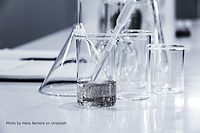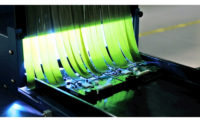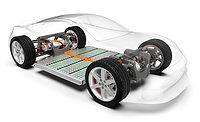Why Nitrogen-Based UV Curing is the Future of Label Making
As UV curing gains in popularity, using nitrogen in the curing process produces better results for pressure sensitive adhesives.

Photo courtesy of Smith Corona
The label making process is often broken down into the sandwich analogy: different layers of chemicals and materials are combined to form a single label. A key ingredient in this process is silicone, which is essential to get ultra-sticky adhesive to release from the liner material when labels are being applied. For this to properly work, the silicone must be cured.
Most laminators in the label industry use a thermal method to cure their silicone. However, there is another option that can provide a better cure and, ultimately, a better label. That’s through UV curing, which is able to produce high-quality labels through the use of nitrogen gas. What is it about nitrogen-based UV curing that gives it an advantage over thermal curing? This article will review the curing methods used in label making and explain why using UV and nitrogen together produces a better cure for pressure sensitive labels.
Different Curing Methods
First, let’s do a little background on the whole curing process. Silicone is a coating applied to label liners that protects the liner from adhesive and provides an easy release. When silicone is cured, this simply means that it’s dried. There are different technologies used in label production that accomplish this. The two main methods are thermal and ultraviolet (UV).
Both methods operate using completely different processes, each with their own pros and cons that are worth exploring. Below are the pros and cons of thermal and UV curing technologies.
UV curing:
- Uses electricity
- Faster curing process
- Small oven size (takes up less space)
- Uses significantly less energy and emissions to cure
- Requires expensive coatings
- Benefit of higher durability and gloss characteristics
Thermal curing:
- Uses heat/natural gas
- Slower curing process
- Requires large ovens to run
- High oven temps can affect liner material
- Lower cost to operate
Thermal Curing
The most common and widely used method to thermally cure silicone in the label industry is through the use of solventless thermal silicone. This is due to its compatibility with a wide range of adhesives and significantly lower operating costs than UV-curable silicones.
To thermally cure silicone requires the use of large ovens, which generate high temperatures (around 200 °F) that are necessary for the proper chemical reactions to take place. These ovens combust natural gas for heat, and can be expensive to purchase, maintain, and run. However, using high heat does have drawbacks on both paper and film liner materials. Depending on the material, liners can curl, stretch, and shrink. When this happens, laminators are forced to slow their operations. Slower speeds result in less efficiency and higher running costs.
Because it uses natural gas, thermally cured silicone generates large amounts of energy. Unfortunately, this makes it less of a sustainable option for businesses looking to minimally impact the environment.
UV Curing
While not as widely used in the label industry, there are benefits UV-curing offers to both labels and the facilities using it. Ultraviolet or UV cure silicones utilize electricity instead of heat. The chemical reaction that occurs provides an instant cure to the silicone, rapidly reducing process time. This means liner material can be run at full speed with no loss in efficiency while maintaining high productivity. Without the use of natural gas, UV curing generates less pollutants, resulting in fewer emissions and significantly lower energy use, all factors that are extremely beneficial for sustainability initiatives.
Because UV doesn’t use heat to cure, paper and film materials are able to remain in perfect condition for more reliable and consistent results. And for film materials, UV curing has the added benefits of increasing durability and providing gloss characteristics.
UV equipment also demands substantially less floor space compared to the traditionally large stretches of ovens for thermal curing.
However, there are a few drawbacks of UV curing. For silicone to be cured by UV light, special coatings that have been specially modified are required. These coatings are more expensive than standard coatings used in thermal curing and can add to a company’s operating costs for this method.
Clearly UV curing offers benefits to label making that thermal curing simply can’t. But to achieve these benefits, the right environment must be created. This is where nitrogen enters the equation.
Nitrogen in UV Curing
Nitrogen is used in many applications throughout a wide range of industries, like steel, agricultural, chemical, and beverage. In label making, it helps create the right environment for UV light to cure silicone.
Nitrogen is an inert gas, meaning it’s non-reactive in the presence of other gases. It can also help control the level of other gases, like oxygen. And for UV silicone to cure, it needs an oxygen-free environment. The presence of oxygen negatively affects the chemical reactions that take place during the curing process, resulting in silicone being sticky, tacky, and greasy. Any of these attributes will ultimately result in a defective label with a poor release.
To control oxygen levels, nitrogen gas is continuously supplied to the UV environment so it floods out any remaining gas particles. This helps reduce warping, curing, or yellowing of labels caused by oxygen. However, for UV silicone to be effective and reduce these factors, a high purity of nitrogen is necessary. How pure? 99.999%. To maintain this high level of product quality, using the right equipment to optimize nitrogen output becomes essential. This ensures proper label production and efficiency.
Businesses wishing to utilize nitrogen for UV curing can do this by partnering with a chemical supplier that will deliver the nitrogen gas via truckloads. While rare, some large-scale corporations choose to make their own nitrogen through the use of an on-site nitrogen generation system. This type of equipment allows for maximum transparency throughout the nitrogen-making process and improves reliability over the reliance of having nitrogen brought in by truck.
Conclusion
UV curing with nitrogen is on its way to becoming one of the best ways to enhance the quality of pressure sensitive adhesive labels. While not the most traditional method, the benefits UV curing offers to label production, product quality, and sustainable initiatives make it a likely candidate for increased usage in the label industry going forward.
Learn more about Smith Corona at www.smithcorona.com.
Looking for a reprint of this article?
From high-res PDFs to custom plaques, order your copy today!





